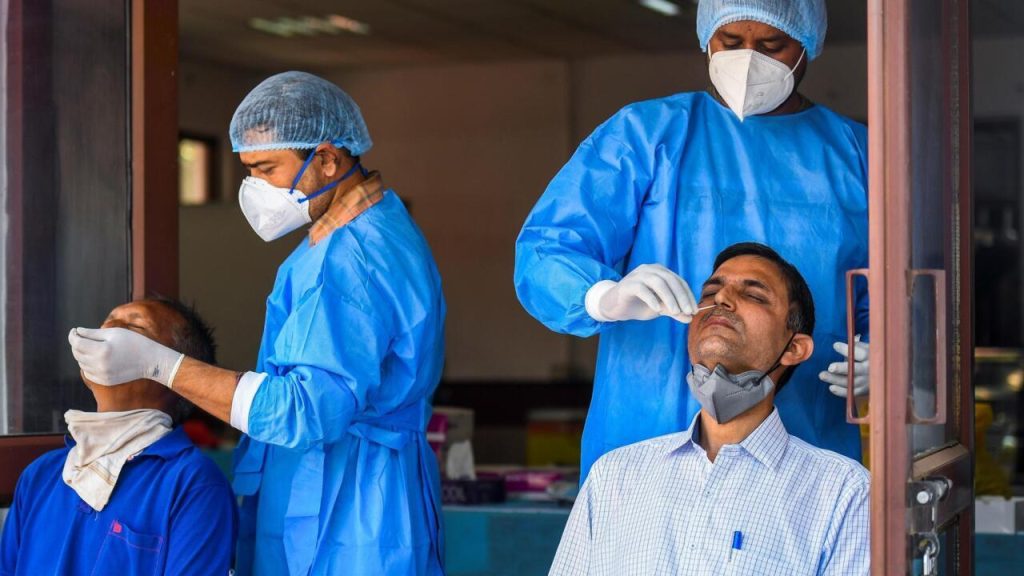Our Terms & Conditions | Our Privacy Policy
New COVID-19 variants spark surge in India
 Health workers collect swab samples from employees of the Indian Agricultural Research Institute (IARI) for the Covid-19 coronavirus test in New Delhi on October 8, 2020. (Photo by Prakash SINGH / AFP)
Health workers collect swab samples from employees of the Indian Agricultural Research Institute (IARI) for the Covid-19 coronavirus test in New Delhi on October 8, 2020. (Photo by Prakash SINGH / AFP)
After five years of COVID-19, the pathogen has again hit the country with its new variant NB.1.8.1 and LF.7 with Indian health authorities closely monitoring the situation in metropolitan cities and some southern states.
A total of 1,010 cases of COVID-19 have been reported in India as of May 28 with Kerala leading in the number of cases, with over 430 cases and two deaths among comorbidities, stated the union health ministry. Maharashtra and Delhi have reported 210 and 104 cases respectively.
Reportedly, most of the fresh cases are mild with very few requiring hospitalization, and deaths have largely been among those with pre-existing conditions. States like Delhi, Maharashtra, Karnataka, Gujarat and Telangana have seen spikes, particularly in cities like Mumbai, Bengaluru, and Hyderabad.
In 2020 March when the first COVID-19 hit the entire world, India witnessed two unfortunate waves of the virus resulting in a huge number of deaths. Kerala was the first to report the case of COVID. The situation remained critical for over two years claiming more than 50,000 lives.
Due to the spread of the virus, many industries had come to an indefinite halt resulting in huge losses and bankruptcy. The Indian economy was impacted severely with many companies deciding to allow employees to work from home with pay cuts turning this situation into a new normal.
The current strain of the COVID-19 virus as reported by INSACOG data, are protein mutations of the JN.1 virus. Initial research indicates that the NB.1.8.1 variant could be more transmissible than previous strains, likely due to its stronger binding ability to human cells. To date, 58 genome sequences of NB.1.8.1 have been submitted to the global COVID-19 database, originating from 22 different countries.
The NF.7 variant was observed largely in southern parts of India and both NB.1.8.1 and NF.7 have been reported largely from urban metro cities. However, international cases from the US have also reported high communicability.
The symptoms of the virus are observed to be mild. As per the reports by World Health Organisation (WHO), the NB.1.8.1 poses a low global health risk. However, some symptoms have been identified as sore throat, fatigue, mild cough, fever, muscle aches, nasal congestion, low-grade hyperthermia, headaches, nausea and gastrointestinal issues.
Like in the previous era of COVID-19, the experts suggest taking the Rapid Antigen Test or RT-PCR test if one comes across these symptoms for more than three to four days. The experts have also warned people to avoid going in crowded places.
As of now, there are 7 deaths reported so far from Maharashtra, Karnataka, Rajasthan and Kerala.
Meanwhile, this highly contagious COVID-19 variant has now been detected in the US, including in New York City, according to the Centres for Disease Control and Prevention (CDC).
Although the number of confirmed cases in the US remains low, experts are raising concerns about the variant’s rapid spread in China and parts of Asia, where it has already become the dominant strain. In Hong Kong, health officials reported a significant surge in COVID-related hospitalisations and emergency room visits over the past month, especially among the elderly, the New York Post reported
[ad_1]
Images are for reference only.Images and contents gathered automatic from google or 3rd party sources.All rights on the images and contents are with their legal original owners.
[ad_2]



Comments are closed.